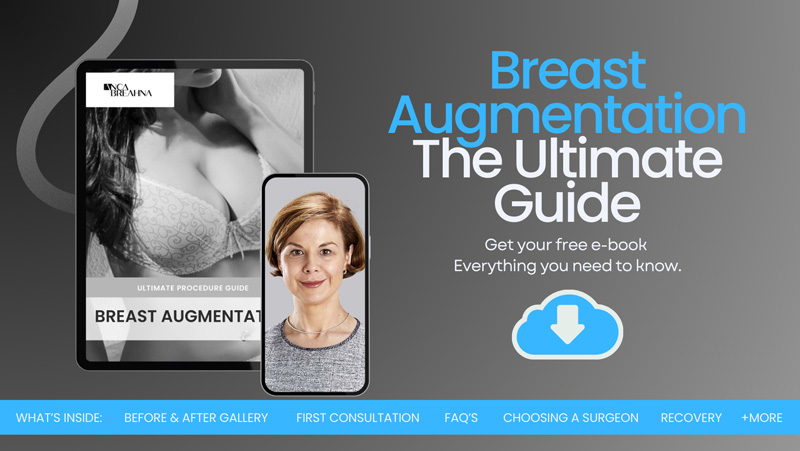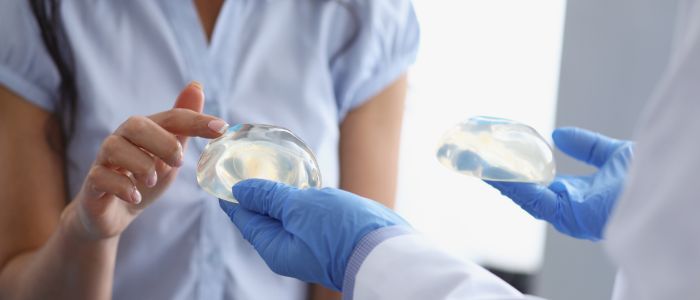
- Subtle Enhancement with Smaller Breast Implants
- Download the Breast Augmentation Guide
- More about Breast Augmentation
- Choosing the Right Surgeon for a Natural Looking Breast Augmentation
- Types of Implants for Natural Looking Breast Augmentation
- Determining the Appropriate Implant Size
- Body Type and Chest Structure
- Avoiding Oversized Implants for a Natural Look
- Risks Associated with Breast Augmentation
- Potential Risks and Complications
- Smaller Implants May Reduce Risks
- Importance of Post-Surgery Guidelines
- FAQs about How to Get a Natural Looking Breast Augmentation Using Smaller Implants
- Can smaller breast implants still provide a significant enhancement?
- How long do smaller implants last, and will they need to be replaced?
- Will I be able to breastfeed after getting smaller implants?
- How do I choose between round and teardrop-shaped smaller implants for a natural look?
- Is the recovery period shorter for breast augmentation with smaller implants?
- Further Reading about Breast Augmentation with Chester Consultant Plastic Surgeon Anca Breahna
- Medical References about Breast Augmentation Using Smaller Implants
Subtle Enhancement with Smaller Breast Implants
Breast augmentation, a surgical procedure to enhance breast size, has long been a popular choice for women seeking to improve their body contours. In recent years, there’s been a noticeable shift in preference towards more natural-looking results. This evolving trend is steering away from the once common choice of larger implants to a more subtle and understated enhancement. In this blog Chester Consultant Plastic Surgeon Anca Breahna offers a guide on achieving a natural-looking breast augmentation using smaller implants.
Download the Breast Augmentation Guide

More about Breast Augmentation
Breast augmentation, often referred to as augmentation mammoplasty, is a surgical procedure aimed at enhancing the size and shape of a woman’s breasts. Traditionally, this surgery has been sought after for various reasons, ranging from enhancing body proportion to rectifying asymmetry between the breasts. The core purpose, irrespective of the individual reasons, is to modify the breast size in a way that aligns with the patient’s aesthetic aspirations.
When it comes to cosmetic surgery, a significant shift has been observed in the preference for breast implants. Over recent years, the trend has leaned increasingly towards smaller, more proportionate implants. This change reflects a growing desire among women to achieve a more natural, understated enhancement of their breasts. The reason behind this trend is not just about augmentation but also about ensuring that the results harmonise with the natural body shape.
The benefits of opting for smaller implants are manifold and significant in terms of both aesthetics and health:
- A More Natural Appearance: Smaller implants offer a subtler enhancement, blending seamlessly with the body’s natural contours — a look that’s increasingly in demand as small boobs become more celebrated in today’s beauty trends. This results in a more balanced and proportionate figure, avoiding the overtly augmented look that larger implants might create
- Enhanced Comfort and Mobility: With smaller implants, patients often report greater comfort and ease of movement. This is particularly noteworthy for those who lead an active lifestyle, as larger implants can sometimes pose limitations on physical activities
- Reduced Risk of Complications: Smaller implants are associated with a lower likelihood of complications such as implant rupture or capsular contracture (a condition where scar tissue forms around the implant, causing discomfort or changes in breast appearance)
- Less Strain on Body Structure: Larger implants can exert additional pressure on the chest and back, potentially leading to discomfort or posture issues. Smaller implants, being lighter, tend to alleviate such concerns, ensuring a more comfortable long-term experience
- Smoother Recovery Process: Generally, surgeries involving smaller implants are less invasive, which can lead to a smoother, quicker recovery process. This means less time off work or away from daily activities, which is an important consideration for many
- Longevity of Results: Smaller implants can contribute to the longevity of the surgical results. They maintain their shape and positioning better over time, as they exert less stress on the surrounding tissues
Choosing the Right Surgeon for a Natural Looking Breast Augmentation
Selecting a certified and experienced plastic surgeon is of utmost importance when considering how to get natural looking breasts. The skill and expertise of your surgeon play an essential role in determining the success and satisfaction with the final outcome of your procedure.
A qualified plastic surgeon brings a combination of extensive training, clinical experience, and an artistic eye essential for achieving the desired aesthetic results. Here are some factors to consider when choosing your plastic surgeon:
- Professional Certification: Ensure your plastic surgeon is certified by a recognised professional body. Certification is an assurance that your surgeon has undergone rigorous training and meets the high standards required in the field
- Specialisation in Breast Procedures: Look for a surgeon who specialises in breast augmentation. Surgeons with a focus on breast procedures are likely to be more adept and up-to-date with the latest techniques and advancements in this specific area
- Experience and Track Record: Consider the level of experience your surgeon has. How many breast augmentation procedures have they performed? Experienced surgeons are more likely to handle unexpected situations effectively and deliver consistent results
- Before-and-After Photos: Reviewing before-and-after photos of previous patients who had similar procedures can provide insights into your surgeon’s capability to deliver natural-looking results. Pay attention to patients who have a similar body type to yours
- Patient Reviews and Testimonials: Patient reviews can offer valuable information about their experiences. Positive reviews can be a good indicator of your surgeon’s competence and the quality of care provided
- Consultation Approach: A good surgeon should provide a thorough consultation, offering personalised advice. They should be willing to listen to your needs, discuss your options, and answer any questions you may have
Types of Implants for Natural Looking Breast Augmentation
When considering breast augmentation with smaller implants, it’s essential to understand the various types available and how they contribute to achieving a natural appearance. The primary types of implants used in breast augmentation are silicone and saline, each with distinct characteristics and advantages.
- Silicone Implants: Silicone implants are filled with a silicone gel that closely mimics the feel of human fat, making them popular for their natural feel and consistency. They are less likely to wrinkle or ripple compared to saline implants, which is a significant factor in maintaining a natural look, especially in individuals with thinner breast tissue. Silicone implants come in various sizes and shapes, allowing for a tailored fit to your body. Additionally, they are less likely to deflate or leak compared to their saline counterparts. However, it is important to note that silicone implants require regular monitoring, usually through an MRI or ultrasound, to detect any potential leaks or ruptures, as they are not always immediately apparent
- Saline Implants: Saline implants consist of a silicone shell filled with sterile saltwater. The primary advantage of saline implants is their safety aspect; in case of a rupture, the body can safely absorb the saline solution. Another benefit is that saline implants are filled after insertion, allowing for minor adjustments in size during surgery for better symmetry. They are also generally less expensive than silicone implants. However, they might feel less natural compared to silicone and are more prone to rippling, which could be a consideration if you are seeking a very natural look and feel
The choice between silicone and saline implants is a personal one and should be made in consultation with Anca, considering your body type, aesthetic goals, and lifestyle.
Beyond the type of implant, other factors that influence the final appearance include the implant’s texture, shape, and profile:
- Implant Texture: Implants come in smooth and textured varieties. Textured implants are designed to reduce the risk of capsular contracture, a condition where scar tissue forms around the implant, leading to hardness. They may also be less likely to move around within the breast
- Implant Shape: Implants can be round or shaped (often referred to as anatomical or teardrop). Round implants provide a fuller appearance at the top of the breasts, while teardrop-shaped implants mimic the natural slope of the breast, leading to a more subtle enhancement
- Implant Profile: The profile of an implant refers to how much it projects from the chest. Lower profile implants offer a more subtle enhancement, while higher profiles provide more projection. The choice of profile depends on your chest dimensions and desired outcome
When choosing implants for a natural-looking breast augmentation, it’s not just about size but also about selecting the right combination of type, texture, shape, and profile that complements your body’s natural anatomy. Anca will guide you through this selection process, ensuring that the implants chosen align with your aesthetic goals and physical characteristics. Remember, the goal is to enhance your natural beauty in a way that feels right for you.
Determining the Appropriate Implant Size
When it comes to breast augmentation, one of the most critical decisions is selecting the appropriate implant size. This choice is not merely about preference; it involves a careful consideration of various physical and personal factors. The aim is to achieve a result that not only enhances your appearance but also feels comfortable and natural.
Anca uses a combination of methods to ascertain the most suitable implant size for each individual:
- Measurements and Physical Examination: Anca will take comprehensive measurements of your breasts, including width, height, and skin elasticity. This is crucial in determining the size and type of implant that can be accommodated naturally by your body
- 3D Imaging and Sizers: Anca might use advanced 3D imaging technology or sizers during consultations. These tools help visualise how different sizes and shapes of implants might look on your body
- Discussion of Aesthetic Goals: A thorough discussion about your aesthetic goals is essential. It’s important for Anca to understand the look you are aiming to achieve with the augmentation
Body Type and Chest Structure
Your body type and chest structure are fundamental in choosing the right implant size:
- Body Frame: Women with smaller frames might find that large implants look disproportionate, while those with broader frames may accommodate larger implants more naturally
- Chest Width: The width of your chest determines the maximum width of the implant that can be used without looking unnatural
- Skin Elasticity: The ability of your skin to stretch comfortably with the implant is also a factor. Higher skin elasticity can accommodate larger implants more easily
Avoiding Oversized Implants for a Natural Look
Implant sizes are measured in millilitres (ml). Generally, sizes range from about 100 ml to 800 ml. In the context of seeking a natural look, smaller implants, typically in the range of 150 ml to 350 ml, are often recommended. These sizes tend to provide a subtle enhancement, in harmony with the body’s natural contours. Larger implants, say 400 ml and above, may create a more noticeable, less natural appearance.
Risks Associated with Breast Augmentation
While breast augmentation is a commonly performed and generally safe procedure, like any surgery, it carries certain risks and potential complications. The choice of smaller implants can, in some cases, reduce certain risks associated with breast augmentation.
Potential Risks and Complications
Breast augmentation, regardless of the implant size, involves some inherent risks:
- Infection and Bleeding: As with any surgical procedure, there is a risk of infection and bleeding during or after the surgery
- Scarring: Scarring is an inevitable part of the healing process. The extent and visibility of scars depend on various factors, including your body’s natural healing ability
- Changes in Breast and Nipple Sensation: Some women experience changes in breast or nipple sensation post-surgery, which can be temporary or permanent
- Implant-Related Complications: These include rupture or leakage of the implant, rippling of the implant surface, or capsular contracture, where hard scar tissue forms around the implant
- Asymmetry: Post-surgical asymmetry is a possibility if the implants settle differently or if there are variations in healing
Smaller Implants May Reduce Risks
Choosing smaller implants can mitigate some risks associated with breast augmentation:
- Lower Risk of Capsular Contracture: Smaller implants exert less pressure on the surrounding tissues, potentially reducing the risk of capsular contracture
- Reduced Strain on Tissues: Smaller implants are lighter and put less strain on the breast tissues and skin, which can minimise issues like stretching or sagging
- Lesser Impact on Body Mechanics: Larger implants can alter body balance and posture; smaller implants are less likely to have such an impact
- Easier Detection of Breast Abnormalities: With smaller implants, it might be easier to detect breast lumps or changes during self-examination or mammograms
Importance of Post-Surgery Guidelines
Following post-surgery guidelines is critical for optimal results and minimising complications:
- Adhering to Recovery Protocols: Your surgeon will provide specific instructions for post-operative care, including activity restrictions, wound care, and the use of compression garments
- Monitoring for Complications: Be vigilant for signs of infection, unusual swelling, or changes in breast shape, and report these to your surgeon immediately
- Regular Follow-Up Appointments: Attend all scheduled follow-up appointments so Anca can monitor your recovery and the condition of your implants
- Long-Term Care: This includes self-examination of breasts, regular mammograms, and MRI scans if recommended by your surgeon, particularly for silicone implants
FAQs about How to Get a Natural Looking Breast Augmentation Using Smaller Implants
Can smaller breast implants still provide a significant enhancement?
- Smaller breast implants can offer a noticeable enhancement while maintaining a natural appearance. The key is to choose an implant size and shape that harmonises with your body’s natural contours and proportions. The enhancement is more about achieving a balanced and aesthetically pleasing look rather than just increasing size.
How long do smaller implants last, and will they need to be replaced?
- Smaller implants, like all breast implants, typically have a long lifespan but are not considered lifetime devices. On average, they can last anywhere from 10 to 15 years, sometimes longer. The need for replacement can be due to various factors such as changes in personal preference, lifestyle, body changes, or implant-related issues like rupture. Regular check-ups and monitoring are essential to determine their condition over time.
Will I be able to breastfeed after getting smaller implants?
- In most cases, breast augmentation surgery, even with smaller implants, does not affect your ability to breastfeed. However, it can depend on the surgical technique used. Techniques that involve incisions around the areola might pose a greater risk to milk ducts and nerves. It’s important to discuss your future breastfeeding plans with Anca before the procedure.
How do I choose between round and teardrop-shaped smaller implants for a natural look?
- The choice between round and teardrop-shaped (anatomical) implants depends on your desired aesthetic outcome. Round implants tend to provide a fuller look at the top of the breasts, while teardrop-shaped implants offer a more gradual slope, mimicking the natural breast shape. Anca can help you decide which shape aligns best with your body type and aesthetic goals.
Is the recovery period shorter for breast augmentation with smaller implants?
- The recovery period after breast augmentation can vary from person to person. In general, the use of smaller implants can lead to a potentially shorter and more comfortable recovery period. This is because smaller implants cause less trauma to the tissues and muscles. Nonetheless, it’s important to follow your surgeon’s advice on recovery and not rush the healing process.
Further Reading about Breast Augmentation with Chester Consultant Plastic Surgeon Anca Breahna
- Read more about Breast Augmentation Trends: What’s Popular in 2024?
- Read more about What is Breast Augmentation Surgery?
- Read more about Natural Boob Job – Autologous Fat Transfer to the Breasts
- Read more about Preparing for Breast Augmentation: A Checklist
- Read more about Treating Small Breasts/ Hypomastia/ Amastia
Medical References about Breast Augmentation Using Smaller Implants
- Preoperative Sizing in Breast Augmentation – PubMed
- Matching the Implant to the Breast – PubMed
- What You Need to Know About Breast Augmentation – Medical News Today
- Are You a Good Candidate for Breast Augmentation? – American Society of Plastic Surgeons
- Important Things to Know About Breast Augmentation – American Society of Plastic Surgeons


 Ms Anca Breahna, PhD, MSc, FEBOPRAS, FRCS (Plast) is a highly regarded Consultant Plastic Surgeon specialising in the field of Aesthetic and Reconstructive Plastic Surgery. Anca performs a range of
Ms Anca Breahna, PhD, MSc, FEBOPRAS, FRCS (Plast) is a highly regarded Consultant Plastic Surgeon specialising in the field of Aesthetic and Reconstructive Plastic Surgery. Anca performs a range of 